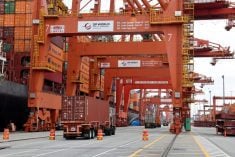Winnipeg — The ICE Futures Canada canola market has moved sharply higher recently, but in some cases the cash market hasn’t rallied less because basis levels have widen.
“Generally we’ve been seeing companies widen their basis levels out a bit. Some have held them steady, some have just crept them out a little bit. There are a few places where they’ve widened them out quite a bit to try and keep the flat price what it had been. So, it really does vary quite a bit by company and region,” said Jon Driedger, market analyst with FarmLink Marketing Solutions in Winnipeg.
Read Also

Canadian trade data delayed by U.S. government shutdown
Canadian international trade data for September will be delayed indefinitely due to the ongoing partial shutdown of the United States government, Statistics Canada said Friday, Oct. 24.
Also the futures rally has attracted some old crop selling and that too is keeping basis levels under pressure.
In coming wheat though, farmers may start to get bullish and hold off on old crop sales and that could result in stronger prices.
The new crop cash market has more upside potential in the coming weeks, said Errol Anderson, president of ProMarket Communications in Calgary.
“I’m fully expecting that the November delivered basis levels in some areas will be going positive above the November futures,” Anderson said.
The generally tight Canadian canola supply situation and recent unfavourable cold weather that caused frost damage to some western Canadian canola crops are keeping the bias pointing higher for new crop canola prices.
“The situation in western Manitoba is significant, and already there’s going to be a snugness of supply. Certainly there’s time to put this crop in but the problem is seed availability, so some guys will just have to put in wheat,” he added.
“So, this to me is fundamentally changing canola for the next 18 months; it’s significant.”
Demand for canola should remain strong enough to keep new crop cash prices underpinned as well, though economic problems in China and Japan could cause some bumps in the road.
“China and Japan are definitely critical to the success of this rally,” Anderson said.
Anderson expects the new crop November canola future to break into the $500 to $550 per tonne trading range, which could mean $12 per bushel canola in some areas if basis levels are positive.














